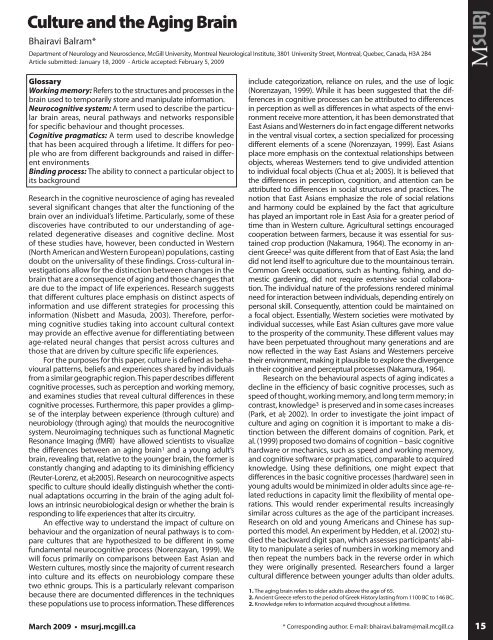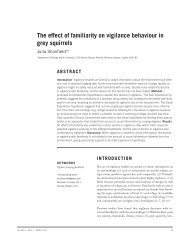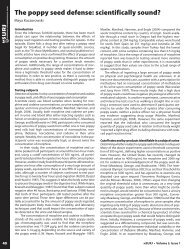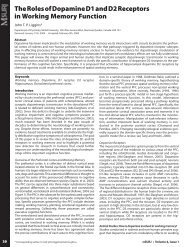the entire issue - McGill Science Undergraduate Research Journal ...
the entire issue - McGill Science Undergraduate Research Journal ...
the entire issue - McGill Science Undergraduate Research Journal ...
You also want an ePaper? Increase the reach of your titles
YUMPU automatically turns print PDFs into web optimized ePapers that Google loves.
Culture and <strong>the</strong> Aging Brain<br />
Bhairavi Balram*<br />
Department of Neurology and Neuroscience, <strong>McGill</strong> University, Montreal Neurological Institute, 3801 University Street, Montreal, Quebec, Canada, H3A 2B4<br />
Article submitted: January 18, 2009 - Article accepted: February 5, 2009<br />
Glossary<br />
Working memory: Refers to <strong>the</strong> structures and processes in <strong>the</strong><br />
brain used to temporarily store and manipulate information.<br />
Neurocognitive system: A term used to describe <strong>the</strong> particular<br />
brain areas, neural pathways and networks responsible<br />
for specific behaviour and thought processes.<br />
Cognitive pragmatics: A term used to describe knowledge<br />
that has been acquired through a lifetime. It differs for people<br />
who are from different backgrounds and raised in different<br />
environments<br />
Binding process: The ability to connect a particular object to<br />
its background<br />
<strong>Research</strong> in <strong>the</strong> cognitive neuroscience of aging has revealed<br />
several significant changes that alter <strong>the</strong> functioning of <strong>the</strong><br />
brain over an individual’s lifetime. Particularly, some of <strong>the</strong>se<br />
discoveries have contributed to our understanding of agerelated<br />
degenerative diseases and cognitive decline. Most<br />
of <strong>the</strong>se studies have, however, been conducted in Western<br />
(North American and Western European) populations, casting<br />
doubt on <strong>the</strong> universality of <strong>the</strong>se findings. Cross-cultural investigations<br />
allow for <strong>the</strong> distinction between changes in <strong>the</strong><br />
brain that are a consequence of aging and those changes that<br />
are due to <strong>the</strong> impact of life experiences. <strong>Research</strong> suggests<br />
that different cultures place emphasis on distinct aspects of<br />
information and use different strategies for processing this<br />
information (Nisbett and Masuda, 2003). Therefore, performing<br />
cognitive studies taking into account cultural context<br />
may provide an effective avenue for differentiating between<br />
age-related neural changes that persist across cultures and<br />
those that are driven by culture specific life experiences.<br />
For <strong>the</strong> purposes for this paper, culture is defined as behavioural<br />
patterns, beliefs and experiences shared by individuals<br />
from a similar geographic region. This paper describes different<br />
cognitive processes, such as perception and working memory,<br />
and examines studies that reveal cultural differences in <strong>the</strong>se<br />
cognitive processes. Fur<strong>the</strong>rmore, this paper provides a glimpse<br />
of <strong>the</strong> interplay between experience (through culture) and<br />
neurobiology (through aging) that moulds <strong>the</strong> neurocognitive<br />
system. Neuroimaging techniques such as functional Magnetic<br />
Resonance Imaging (fMRI) have allowed scientists to visualize<br />
<strong>the</strong> differences between an aging brain 1 and a young adult’s<br />
brain, revealing that, relative to <strong>the</strong> younger brain, <strong>the</strong> former is<br />
constantly changing and adapting to its diminishing efficiency<br />
(Reuter-Lorenz, et al,2005). <strong>Research</strong> on neurocognitive aspects<br />
specific to culture should ideally distinguish whe<strong>the</strong>r <strong>the</strong> continual<br />
adaptations occurring in <strong>the</strong> brain of <strong>the</strong> aging adult follows<br />
an intrinsic neurobiological design or whe<strong>the</strong>r <strong>the</strong> brain is<br />
responding to life experiences that alter its circuitry.<br />
An effective way to understand <strong>the</strong> impact of culture on<br />
behaviour and <strong>the</strong> organization of neural pathways is to compare<br />
cultures that are hypo<strong>the</strong>sized to be different in some<br />
fundamental neurocognitive process (Norenzayan, 1999). We<br />
will focus primarily on comparisons between East Asian and<br />
Western cultures, mostly since <strong>the</strong> majority of current research<br />
into culture and its effects on neurobiology compare <strong>the</strong>se<br />
two ethnic groups. This is a particularly relevant comparison<br />
because <strong>the</strong>re are documented differences in <strong>the</strong> techniques<br />
<strong>the</strong>se populations use to process information. These differences<br />
March 2009 • msurj.mcgill.ca<br />
include categorization, reliance on rules, and <strong>the</strong> use of logic<br />
(Norenzayan, 1999). While it has been suggested that <strong>the</strong> differences<br />
in cognitive processes can be attributed to differences<br />
in perception as well as differences in what aspects of <strong>the</strong> environment<br />
receive more attention, it has been demonstrated that<br />
East Asians and Westerners do in fact engage different networks<br />
in <strong>the</strong> ventral visual cortex, a section specialized for processing<br />
different elements of a scene (Norenzayan, 1999). East Asians<br />
place more emphasis on <strong>the</strong> contextual relationships between<br />
objects, whereas Westerners tend to give undivided attention<br />
to individual focal objects (Chua et al., 2005). It is believed that<br />
<strong>the</strong> differences in perception, cognition, and attention can be<br />
attributed to differences in social structures and practices. The<br />
notion that East Asians emphasize <strong>the</strong> role of social relations<br />
and harmony could be explained by <strong>the</strong> fact that agriculture<br />
has played an important role in East Asia for a greater period of<br />
time than in Western culture. Agricultural settings encouraged<br />
cooperation between farmers, because it was essential for sustained<br />
crop production (Nakamura, 1964). The economy in ancient<br />
Greece 2 was quite different from that of East Asia; <strong>the</strong> land<br />
did not lend itself to agriculture due to <strong>the</strong> mountainous terrain.<br />
Common Greek occupations, such as hunting, fishing, and domestic<br />
gardening, did not require extensive social collaboration.<br />
The individual nature of <strong>the</strong> professions rendered minimal<br />
need for interaction between individuals, depending <strong>entire</strong>ly on<br />
personal skill. Consequently, attention could be maintained on<br />
a focal object. Essentially, Western societies were motivated by<br />
individual successes, while East Asian cultures gave more value<br />
to <strong>the</strong> prosperity of <strong>the</strong> community. These different values may<br />
have been perpetuated throughout many generations and are<br />
now reflected in <strong>the</strong> way East Asians and Westerners perceive<br />
<strong>the</strong>ir environment, making it plausible to explore <strong>the</strong> divergence<br />
in <strong>the</strong>ir cognitive and perceptual processes (Nakamura, 1964).<br />
<strong>Research</strong> on <strong>the</strong> behavioural aspects of aging indicates a<br />
decline in <strong>the</strong> efficiency of basic cognitive processes, such as<br />
speed of thought, working memory, and long term memory; in<br />
contrast, knowledge 3 is preserved and in some cases increases<br />
(Park, et al, 2002). In order to investigate <strong>the</strong> joint impact of<br />
culture and aging on cognition it is important to make a distinction<br />
between <strong>the</strong> different domains of cognition. Park, et<br />
al. (1999) proposed two domains of cognition – basic cognitive<br />
hardware or mechanics, such as speed and working memory,<br />
and cognitive software or pragmatics, comparable to acquired<br />
knowledge. Using <strong>the</strong>se definitions, one might expect that<br />
differences in <strong>the</strong> basic cognitive processes (hardware) seen in<br />
young adults would be minimized in older adults since age-related<br />
reductions in capacity limit <strong>the</strong> flexibility of mental operations.<br />
This would render experimental results increasingly<br />
similar across cultures as <strong>the</strong> age of <strong>the</strong> participant increases.<br />
<strong>Research</strong> on old and young Americans and Chinese has supported<br />
this model. An experiment by Hedden, et al. (2002) studied<br />
<strong>the</strong> backward digit span, which assesses participants’ ability<br />
to manipulate a series of numbers in working memory and<br />
<strong>the</strong>n repeat <strong>the</strong> numbers back in <strong>the</strong> reverse order in which<br />
<strong>the</strong>y were originally presented. <strong>Research</strong>ers found a larger<br />
cultural difference between younger adults than older adults.<br />
1. The aging brain refers to older adults above <strong>the</strong> age of 65.<br />
2. Ancient Greece refers to <strong>the</strong> period of Greek History lasting from 1100 BC to 146 BC.<br />
2. Knowledge refers to information acquired throughout a lifetime.<br />
* Corresponding author. E-mail: bhairavi.balram@mail.mcgill.ca<br />
15









